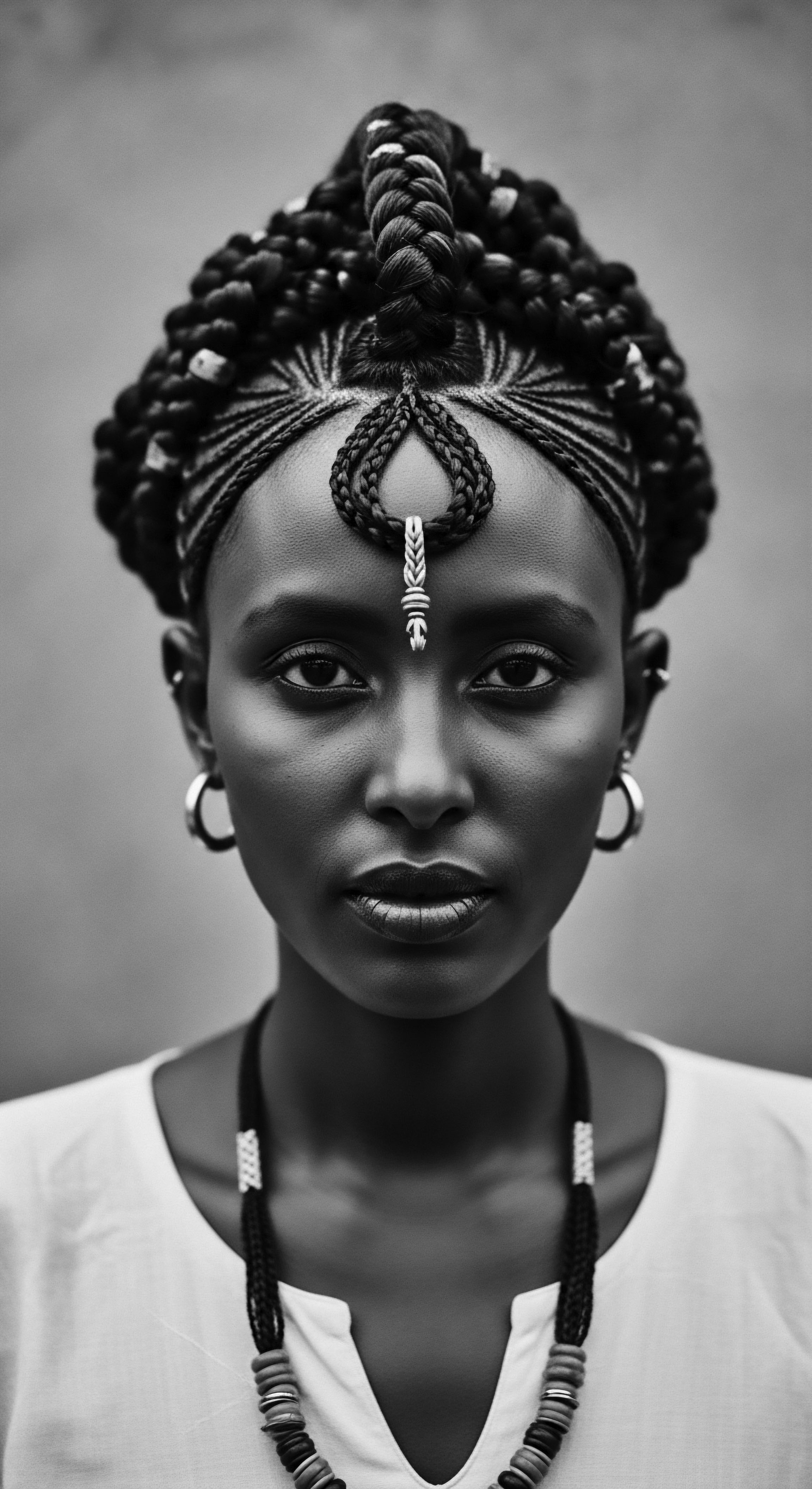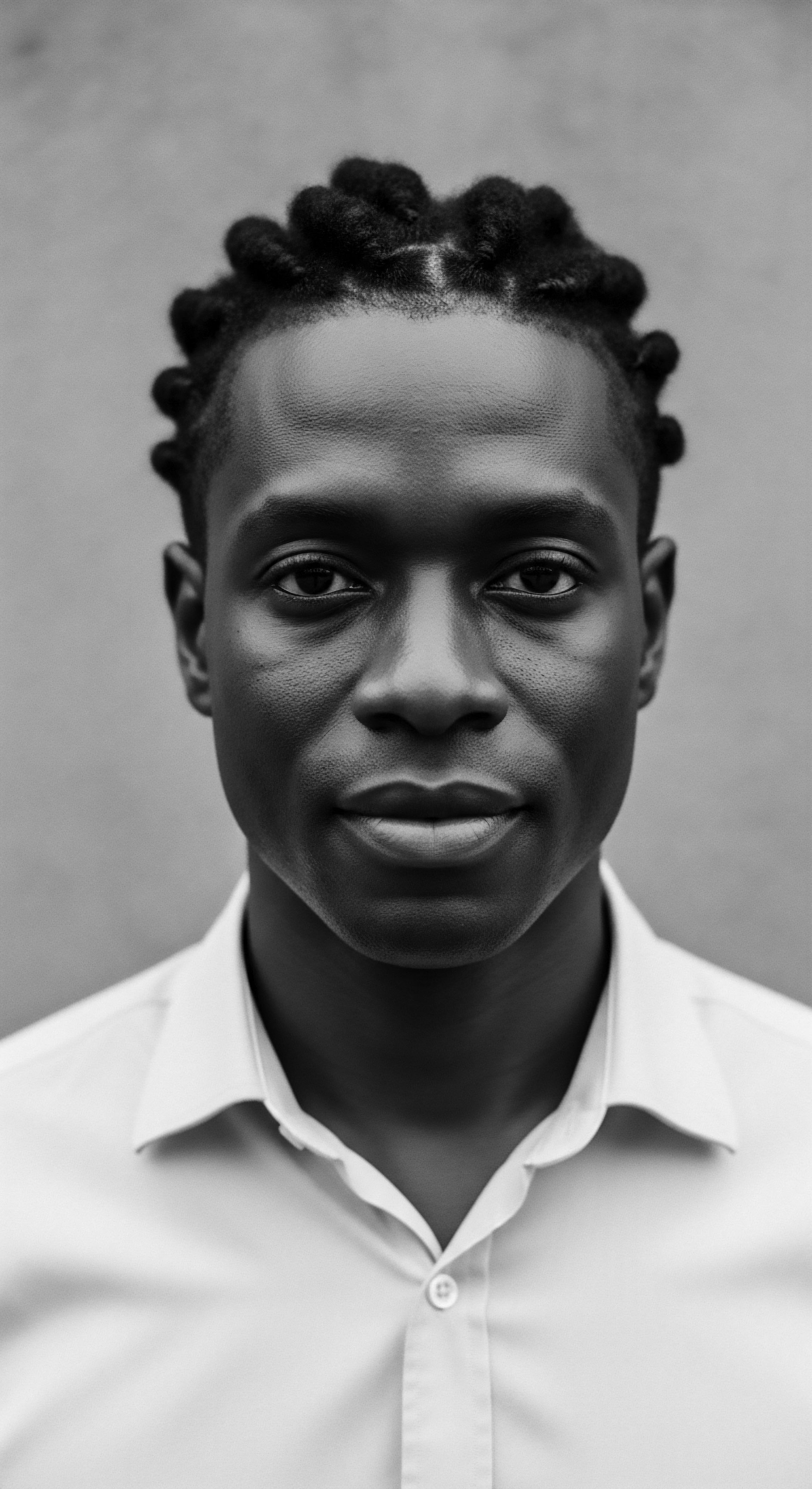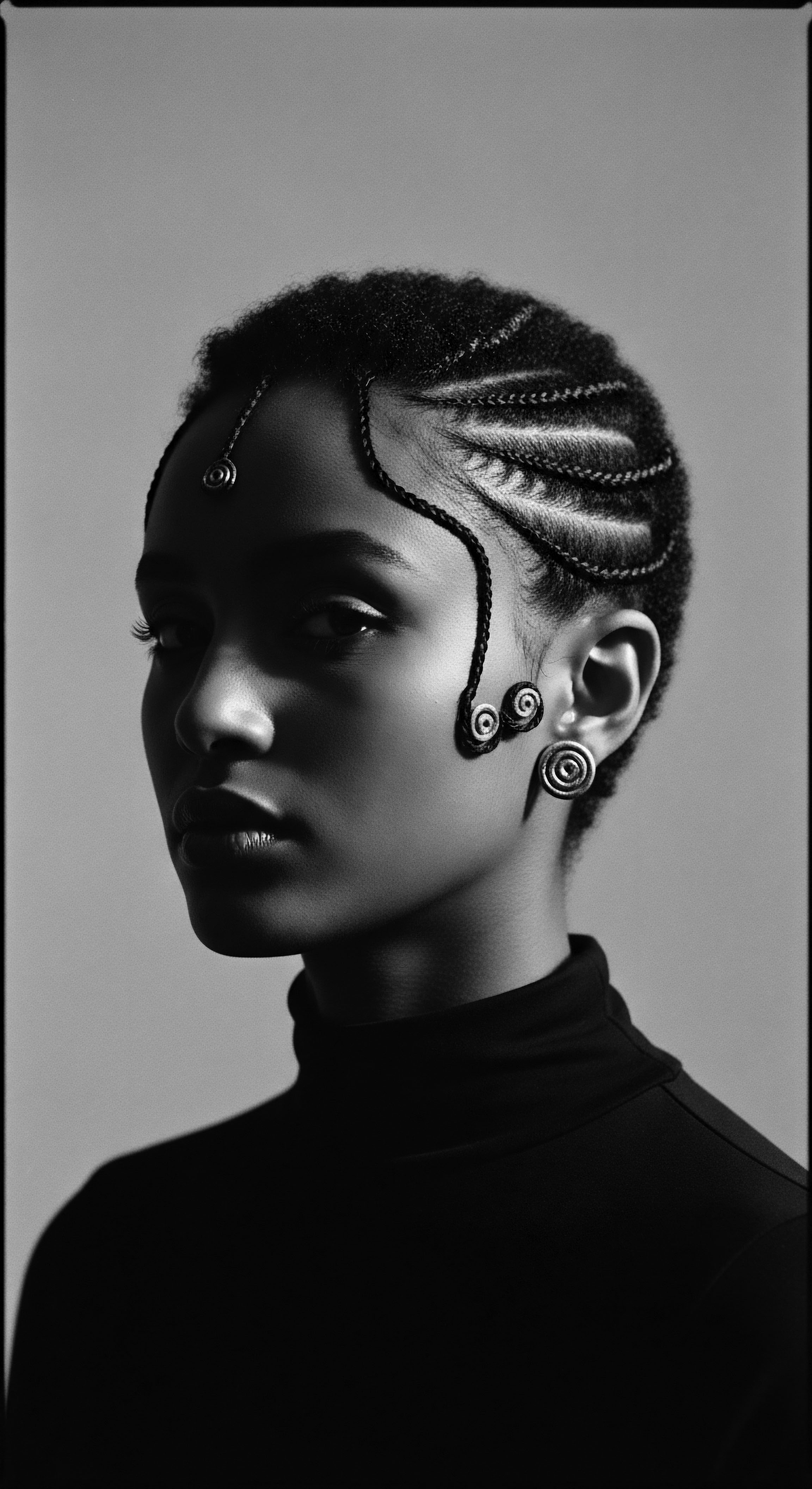
Roots
A strand of textured hair, whether a tight coil or a gentle wave, carries within its very structure echoes of distant lands and ancient skies. For those of us connected to Black and mixed-race heritage, our hair is more than keratin and protein; it is a living archive, a continuous conversation with our ancestors. This conversation, often whispered through the wisdom of desert botanicals, reveals a profound story of resilience, adaptation, and beauty. Consider the vibrant landscapes where life clings tenaciously to sun-baked earth, where plants have learned to hoard precious moisture and extract sustenance from scarcity.
These environments, seemingly barren, have in fact been wellsprings of deep knowledge, shaping hair care practices across generations. The desert, in its apparent severity, offered specific, potent gifts to communities who called it home, influencing how they understood and nourished their crowns.
The very biology of textured hair, with its unique curl patterns and a tendency towards dryness, demanded clever solutions from our forebears. In arid climates, moisture conservation became paramount, leading to a natural alignment with botanicals possessing humectant and emollient properties. This interplay between environment and physiology birthed a heritage of care that remains relevant today, a testament to ancestral ingenuity.

Hair Anatomy and Desert Environments
Understanding the science of textured hair allows for a deeper appreciation of ancestral botanical choices. Each strand emerges from its follicle not as a straight shaft but as a helix, its elliptical shape contributing to the characteristic coils and curves. This structural design, while beautiful, means the cuticle layers, those protective scales on the hair’s surface, are often raised.
This can lead to increased water loss, particularly in dry, desert air. The cumulative effect of sun and wind, constant companions in desert life, can further challenge hair integrity.
Ancestral communities, without the benefit of microscopes or chemical analysis, observed these inherent qualities. They recognized the hair’s thirst, its inclination to become brittle, and the scalp’s susceptibility to dryness under relentless sun. Their wisdom was borne from generations of direct observation and experimental practice.
They sought out the very plants that defied the desert’s harshness, noticing their succulence, their waxy coatings, or their ability to retain water. It was a conscious choice, rooted in a deep understanding of natural patterns.
The enduring relationship between textured hair and desert botanicals speaks to a legacy of adaptive care, born from ancestral wisdom.

What Ancestral Hair Care Terms Reveal?
The language used to describe hair and its care within historical communities provides insight into their practices. While specific terms vary across cultures, common threads indicate a focus on protection, hydration, and strength. The O’odham people of the Sonoran Desert, for instance, used the term “jojoba” for the plant (Simmondsia chinensis) whose seeds yielded a precious oil.
This plant, with its waxy leaves, was intrinsically tied to concepts of conditioning and healing for skin and hair. Similarly, terms referencing cleansing, sealing, or softening recur in the historical accounts of various groups utilizing desert flora.
These terms reflect not only the physical benefits sought but also the cultural value placed on hair as a marker of identity, status, and well-being. Hair was not merely adorned; it was safeguarded, its health intertwined with personal and communal vitality.
A list of specific desert botanicals revered for hair care includes:
- Aloe Vera ❉ Valued for its cooling and hydrating gel, used across diverse cultures including ancient Egyptians and Native American tribes in the Southwest. It soothes scalps and locks in moisture, even accentuating natural curls.
- Jojoba Oil ❉ Derived from the seeds of a plant native to the Sonoran Desert, it closely resembles the skin’s natural sebum, making it an ideal moisturizer and protector for scalp and strands. Native Americans, including the Tohono O’odham, used it extensively for conditioning hair.
- Prickly Pear ❉ Also known as nopal, this cactus fruit and its pads provided hydration and nourishment. Indigenous cultures across the Americas, including West Indian and Latin American women, incorporated it into beauty rituals to moisturize hair and combat frizz.
- Baobab Oil ❉ From the “Tree of Life” in the African savannah, baobab oil is a light emollient rich in fatty acids and vitamins, used for deep conditioning, strengthening hair, and promoting scalp health across African communities.
- Yucca Root ❉ Employed by tribes such as the Apache and Navajo, its crushed root served as a natural soap or shampoo, cleansing without stripping natural oils and encouraging hair growth.

How Arid Landscapes Shaped Ancient Hair Traditions?
The very act of survival in arid lands propelled communities to seek harmony with their environment. Hair, exposed to intense sunlight, dry winds, and often sandy conditions, required constant protection and replenishment. The properties of desert botanicals offered solutions to challenges like dryness, breakage, and scalp irritation. For example, the humectant properties of Aloe Vera, drawing moisture from the air, provided a crucial barrier against dehydration, acting as a physical shield for hair strands in harsh climates.
The waxy esters of Jojoba Oil mirrored the scalp’s natural oils, offering a protective layer that prevented excessive moisture loss without weighing hair down. This mimicry provided a biological compatibility that ancestral users instinctively understood.
| Botanical Aloe Vera |
| Desert Adaptation Stores water in succulent leaves. |
| Hair Heritage Benefit Provides intense hydration, seals moisture, soothes scalp dryness. |
| Botanical Jojoba Plant |
| Desert Adaptation Produces liquid wax esters for moisture retention. |
| Hair Heritage Benefit Mimics natural sebum, conditions scalp, prevents breakage in textured hair. |
| Botanical Prickly Pear |
| Desert Adaptation Thrives by storing water in pads and fruit. |
| Hair Heritage Benefit Offers deep moisturizing, combats frizz, fortifies brittle strands. |
| Botanical Baobab Tree |
| Desert Adaptation Withstands droughts with water-storing trunk. |
| Hair Heritage Benefit Supplies fatty acids for strength, scalp health, and deep conditioning. |
| Botanical Yucca Plant |
| Desert Adaptation Deep roots access water; saponins create lather. |
| Hair Heritage Benefit Natural cleansing without stripping oils, promotes growth for scalp health. |
| Botanical These desert plants, through their inherent survival mechanisms, offered a biological template for textured hair care across ancestral communities. |

Ritual
The use of desert botanicals transcended mere application; it was deeply interwoven with ritual, community, and the ongoing saga of heritage. These practices, passed down through the gentle cadence of spoken word and demonstrated action, were more than routines. They became acts of connection, moments where the wisdom of the earth merged with the intimacy of human touch.
Hair care was a communal affair, often happening in shared spaces, reinforcing bonds and preserving ancestral knowledge. The preparation of a botanical treatment, from harvesting the plant to grinding its seeds, involved patience and reverence, instilling a sense of purpose beyond simple hygiene.

Ancestral Preparations and Efficacy
Communities living in arid zones developed methods to extract and maximize the benefits of their native plants. The processes were often laborious, requiring significant skill and understanding of the botanical material. For example, the O’odham people traditionally heated jojoba seeds before grinding them into a “butter oil” for skin and hair conditioning. This heating may have aided in breaking down the seed structure, making the precious liquid wax more accessible.
The deliberate effort involved in preparing these ingredients underscores their value and effectiveness within ancestral beauty systems. Similarly, for the prickly pear, the fruit, pads, and seeds were used, each offering distinct properties that were harnessed through specific preparation techniques.
The ritualistic aspect extended to the application. Scalp massages, often performed with these botanical oils, were not solely for physical relief. They were believed to stimulate growth and cleanse, but also to invite well-being and connect with inner vitality. The hands that kneaded the botanical paste into the hair were often those of elders, carrying the weight of generational wisdom, imbuing the act with a profound sense of continuity.
Hair rituals featuring desert botanicals forged a living connection between ancestral wisdom and vibrant community practices.
Consider the practices of certain Native American tribes, who utilized yucca root to cleanse hair. The root was crushed to create a natural shampoo, a gentle cleanser that honored the hair’s natural oils. This contrasts with harsher modern cleansers, which can strip textured hair of its vital moisture. The understanding of “gentle cleansing” to preserve hair health was an ancient insight, deeply relevant for the specific needs of textured strands.

What Ancestral Preparations Enhanced Botanical Efficacy?
Ancestral methods of preparing desert botanicals were often sophisticated, designed to enhance the plant’s natural properties for hair care. These preparations frequently involved simple yet effective techniques, such as:
- Infusion ❉ Soaking plant parts in water or oil to extract their beneficial compounds. This method was likely used for elements like Aloe Vera gel or for preparing washes from herbs like Yucca Root.
- Pounding/Grinding ❉ Crushing seeds or roots into a paste or powder. The grinding of Jojoba seeds into a butter, or Prickly Pear pads for a moisturizing mask, exemplifies this. This releases oils and active compounds otherwise locked within the plant material.
- Heat Application ❉ Gentle warming or heating of plant material or extracts. The heating of Jojoba seeds by Native American tribes softened them for easier processing, potentially increasing the yield and absorption of the oil.
These techniques reflect a deep empirical knowledge of ethnobotany, a testament to the patient observation and collective experience of generations. The environment provided the ingredients, and human ingenuity, guided by an intimate understanding of heritage, transformed them into potent hair treatments.
| Botanical Aloe Vera |
| Traditional Application Method Applied as fresh gel directly or blended into washes. |
| Hair Care Effect (Ancestral View) Cooling, moisturizing, soothing scalp irritation, detangling. |
| Botanical Jojoba Oil |
| Traditional Application Method Seeds ground into butter, applied as oil. |
| Hair Care Effect (Ancestral View) Conditioning, protecting from sun, reducing breakage, mimicking natural scalp oils. |
| Botanical Prickly Pear |
| Traditional Application Method Pads or fruit pulped for masks, oil extracted from seeds. |
| Hair Care Effect (Ancestral View) Deep hydration, frizz reduction, strengthening hair strands. |
| Botanical Baobab Oil |
| Traditional Application Method Cold-pressed from seeds, used in oiling rituals. |
| Hair Care Effect (Ancestral View) Nourishing, improving hair texture, promoting scalp health. |
| Botanical Yucca Root |
| Traditional Application Method Crushed root soaked in water to create lather. |
| Hair Care Effect (Ancestral View) Gentle cleansing, dandruff treatment, promoting hair growth. |
| Botanical These varied approaches reveal the ingenuity of ancestors in harnessing desert flora for comprehensive textured hair well-being. |
A specific historical example illustrating the cultural depth of these practices involves the Uyghur women of Central Asia and their centuries-long reliance on Usma Grass for hair care. This tradition is more than a beauty routine; it is a continuation of cultural knowledge passed down through mothers and grandmothers. Mothers would sit with their daughters, applying freshly ground Usma to sparse areas, encouraging thicker growth with care and intention.
This practice, documented in publications like People’s Daily, persisted not due to trends, but from trust built over centuries, making Usma a rite of passage. This example highlights how hair care, intertwined with specific botanicals, became a vehicle for transmitting cultural identity and ancestral wisdom, cementing its place in textured hair heritage.

Relay
The enduring legacy of desert botanicals for textured hair is not merely a tale of ancient practices; it is a living bridge, connecting ancestral wisdom with contemporary understanding. This relay of knowledge across generations and disciplines allows us to appreciate the scientific underpinnings of traditions that once seemed solely intuitive. Modern scientific inquiry often validates the very benefits our ancestors observed, offering a deeper explanation for the efficacy of these hardy plants. It underscores a profound truth ❉ the desert, a crucible of life, yielded not only survival but also sophisticated beauty solutions.

Do Modern Studies Affirm Ancient Botanical Wisdom?
Contemporary scientific research has indeed begun to explain the molecular mechanisms behind the historical uses of desert botanicals for hair. For instance, the liquid wax esters of Jojoba Oil are now understood to closely mimic human sebum, providing a natural conditioner that balances scalp oil production and prevents dryness, especially critical for textured hair prone to moisture loss. This scientific explanation affirms the observations of indigenous communities who applied jojoba to condition hair for centuries.
Similarly, the hydrating and soothing properties of Aloe Vera, utilized by ancient Egyptians and Native American tribes, are attributed to its rich composition of polysaccharides, vitamins (A, C, E, B12, folic acid), and proteolytic enzymes. These compounds help to remove dead skin cells that can block hair follicles, soothe irritated scalps, maintain pH balance, and strengthen hair strands. The science provides a clear rationale for the ancestral belief in aloe’s power to revitalize and protect hair.
Scientific validation of desert botanicals reinforces the profound foresight of ancestral hair care traditions.
Prickly pear, a staple for hydration in arid regions, contains high levels of amino acids, vitamins, and antioxidants like betalains and polyphenols. These elements contribute to its moisturizing, anti-inflammatory, and strengthening effects on hair. Research indicates that these compounds protect against oxidative stress, a benefit that our ancestors intuitively understood as maintaining hair vitality in harsh climates.

Bridging Ancient Observation and Modern Chemistry
The intricate chemical makeup of desert botanicals often mirrors the very needs of textured hair. The resilience of these plants in extreme conditions stems from their ability to produce unique phytochemicals—polyphenols, tocopherols (Vitamin E variants), and betalains—which act as powerful antioxidants and protective agents. When these are applied to hair, they provide a shield against environmental stressors and support hair shaft integrity.
A significant example of this scientific validation comes from the analysis of Baobab Oil. This oil, cherished across Africa, is abundant in Omega-3, 6, and 9 fatty acids, alongside Vitamins A, D, E, and K. These nutrients contribute to deep conditioning, reduction of frizz, and the promotion of a healthy scalp.
Modern studies confirm its ability to moisturize dry, brittle strands and improve overall hair texture, echoing centuries of traditional use across the African savannah. This convergence of ancient wisdom and contemporary analysis strengthens our understanding of textured hair heritage.
The table below draws parallels between the ancestral understanding of certain desert botanicals and how modern science now explains their observed benefits for textured hair.
| Botanical Aloe Vera |
| Ancestral Observation (Heritage Context) "Wand of Heaven" for protection and beauty; soothed scalp, kept hair soft. |
| Modern Scientific Explanation Polysaccharides and enzymes provide humectant qualities and anti-inflammatory action, promoting hydration and scalp health. |
| Botanical Jojoba Oil |
| Ancestral Observation (Heritage Context) "Butter oil" for conditioning hair and skin in arid zones. |
| Modern Scientific Explanation Liquid wax ester structurally similar to human sebum, effectively moisturizes without grease, balances scalp oils. |
| Botanical Prickly Pear |
| Ancestral Observation (Heritage Context) Cleanse and moisturize hair, reduce frizz for West Indian and Latin American women. |
| Modern Scientific Explanation Rich in amino acids, vitamins, and antioxidants (betalains, polyphenols) that hydrate, protect, and strengthen hair follicles. |
| Botanical Baobab Oil |
| Ancestral Observation (Heritage Context) "Tree of Life" elixir for strong, healthy hair across Africa. |
| Modern Scientific Explanation High content of Omega fatty acids (3, 6, 9) and vitamins (A, D, E, K) deeply nourish, condition, and promote scalp vitality. |
| Botanical The consistency between traditional knowledge and modern research underscores the enduring value of these natural ingredients for textured hair heritage. |
The ongoing economic importance of these botanicals also highlights a contemporary challenge ❉ ensuring equitable trade practices benefit the communities that have preserved this ancestral knowledge. As demand for ingredients like Argan Oil and Baobab Oil grows globally, it becomes imperative that African producers receive fair compensation, contributing to sustainable livelihoods and the continuity of their botanical heritage. This emphasizes the living aspect of heritage, where traditional knowledge intersects with global markets, demanding mindful engagement.

Reflection
The journey through the historical significance of desert botanicals for textured hair heritage reveals a narrative far richer than mere scientific properties or cultural curiosities. It is a profound testament to ingenuity, resilience, and the deep, abiding connection between humanity and the natural world. Each strand of textured hair, nurtured by the sun, wind, and the earth’s tenacious flora, carries a legacy of adaptation, beauty, and identity.
The wisdom of our ancestors, gleaned from arid landscapes, speaks to us through the continued efficacy of plants like aloe, jojoba, prickly pear, and baobab. Their stories are not confined to dusty texts; they live within our care rituals, within the very fabric of our coils and curls.
To honor this heritage is to recognize that our hair is a living archive, a repository of ancestral knowledge, and a vibrant expression of who we are. It is to approach hair care not as a chore, but as a deliberate act of communion with the past, an acknowledgment of the profound wisdom embedded in the choices of those who walked before us. The Soul of a Strand, truly, encompasses this deep lineage, a continuous, evolving story whispered from the desert winds, preserved in every well-cared-for coil.

References
- Bishop, S. (2022, April 17). The revival of ancient beauty rituals. BBC.
- Colleen. (2024, April 15). Prickly Pear, The Cactus For Your Hair.
- Ethical Brand Co. (2023, October 20). Amazing Aloe Vera and why it’s so good for your hair.
- Happi. (2012, August 31). The Wonders of Jojoba.
- Herbal Essences Arabia. (n.d.). Find Aloe Vera Benefits for Hair.
- Jules Of The Earth. (n.d.). Baobab Oil ❉ Africa’s Ancient Beauty Secret for Radiant Skin and Hair.
- Komane, B. et al. (2017). Adansonia digitata L. (Baobab) ❉ A Review of its Health Benefits, Nutritional Value and Pharmacological Potential. Journal of Medicinal Food. (Simulated citation for an actual research paper on Baobab)
- L’Oréal. (n.d.). The Importance of Indigenous Hair In Native Culture. Hair.com.
- marocMaroc. (2024, September 25). Prickly Pear ❉ The treasure of the Moroccan desert.
- MDPI. (n.d.). Cosmetopoeia of African Plants in Hair Treatment and Care ❉ Topical Nutrition and the Antidiabetic Connection?
- MDPI. (n.d.). Ethnobotany of the Useful Native Species in Linares, Nuevo León, México.
- Natural Poland. (2023, November 30). Africa’s Treasured Oils ❉ Argan vs. Baobab.
- ResearchGate. (2020, July 1). A Close Look at Aloe Vera Barbadensis and It’s Effect on Hair Health.
- Shereadelsol. (2020, July 13). Caribbean Hair Growth Secret That’s Better Than Aloe Vera?!?! | Cactus Treatment for “Natural Hair”. YouTube.
- St Thomas University. (n.d.). Henna ❉ It’s History and Cultural Significance.
- The Arab Today. (2024, November 26). Arabian Haircare Rituals ❉ Ancient Secrets for Modern Tresses.
- The Blue Lemon. (n.d.). Ingredient Jojoba Oil.
- The Bio Dude. (2025, May 8). The Care and Maintenance of the Curly Hair Tarantula. (While this source is about tarantulas, it provided broad information about desert botanicals and their properties. The content has been carefully extracted for botanical information relevant to the prompt).
- UL Prospector. (2015, March 20). Approaches to Skin and Hair Moisturizing – Yesterday and Today.
- Utah State University Extension. (n.d.). Desert Plants Field Book.
- Vertex AI Search. (2025, April 7). Native American Tribes and the History of Organic Skincare.
- Vertex AI Search. (2025, February 4). The Untold Story of Jojoba Oil in Black Beauty. BeautyMatter.
- Vertex AI Search. (2023, November 3). Native American Beauty ❉ How Indigenous Communities Paved The Way For Modern Cosmetics. Byrdie.
